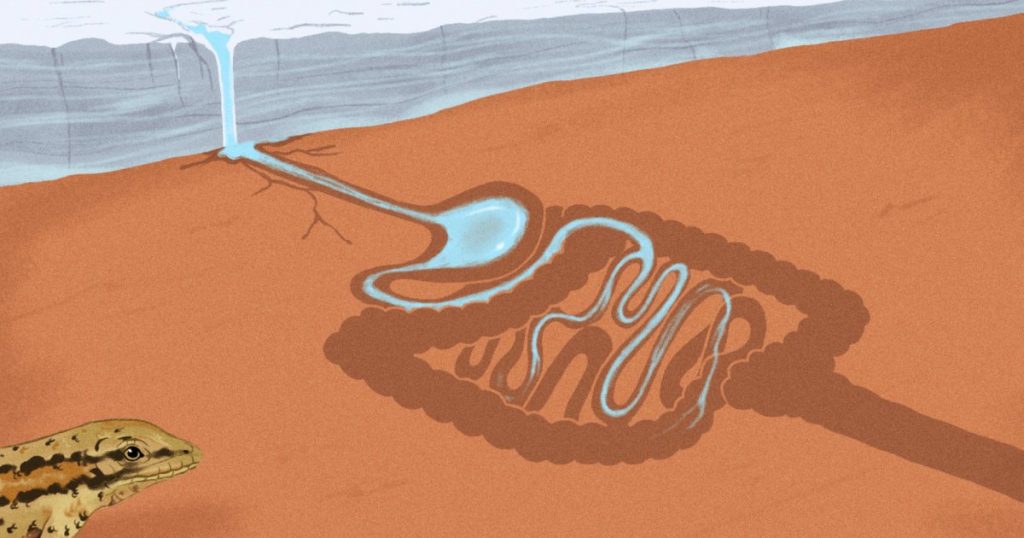I Asked a Bunch of Scientists if Climate Change Was Affecting the Bacteria in My Gut
Grist/Amelia Bates
Looking for news you can trust?Subscribe to our free newsletters.
This story was originally published by Grist and appears here as part of the Climate Desk collaboration.
Those of us who believe in climate change (and maybe some who don’t) jokingly blame all kinds of things on it, from flat tires to summer hailstorms. Case of the flu? Climate change. Mudslide? Climate change. (Usually, we’re right.)
But I was mostly fooling the other day, when I once again said: “Must be climate change.” I was in yet another doctor’s office, doling out obscene amounts of money to be told yet another time that there’s no official diagnosis for what ails my stomach.
The doctor laughed, bemused and dismissive. He was the fifth person I’d seen on behalf of a tummy that no longer properly digested most of the ingredients in the modern American diet—especially the tastiest ones, like dairy, sugar, and wheat.
He mumbled something about the industrial food supply. Though the doc hardly seemed to believe what he muttered, I had a light bulb moment.
I thought about all I’d learned about the American stomach since mine decided to quit, the various ways our processed food-filled diets—not to mention our reliance on antibiotics and antibacterial products—have affected our guts.
As many as 70 million Americans suffer from gastrointestinal issues, with an ongoing increase in celiac disease, food allergies, irritable bowel syndrome, and much else. Until recently, these maladies had been largely confined to the American population. But as our junk food-y diets and hygiene-obsessed lifestyles have been unveiled in the developing world, so have our illnesses. Whatever’s wrong with our stomachs is undergoing a diaspora.
At the same time, there’s been an explosion of interest in the gut microbiome, sometimes called the microbiota—the collection of bacteria, good and bad, that, among many other things, help us digest food and regulate our immune systems.
So if climate change is altering our weather and food supply, I thought, could it possibly be messing up our microbiomes—and thus, our stomachs? My stomach?
The scientific community, it turns out, is just starting to ask similar questions. And as part of my desperate search to divine what ails me—and to follow up on my hunch—I dove into what they’ve found so far.
From the department of the obvious comes this, per a study in The Lancet: “Climate change will affect human health in many ways—mostly adversely.”
“Climate change will affect human health in many ways—mostly adversely.”That global warming will cause shifts in the quantity, frequency, length, and intensity of precipitation is established. And a place where that’s already happening is just outside the Arctic Circle. One investigation looked at how those shifts may affect infectious gastrointestinal illnesses, or IGI—salmonella, giardia, E. coli, and such—focusing on Inuit communities in Nunatsiavut, Canada. It found that large amounts of rainfall were associated with IGI-related clinic visits two and four weeks later.
So, more rain, more tummy ailments, at least for people living more than 1,000 miles north of me. If GI diseases are worsened by extreme weather, and extreme weather is on the rise, that suggests the answer to “Is climate change screwing up our tummies?” could be yes.
But if that answered how outside forces might affect, and infect, our tummies, it didn’t address the internal stomach shifts—or, you know, my own problem. I’m not hosting a bacteria or parasite in my belly, at least as far as I know. I have what seems to be a case of the microbiome blues—the kind that appear to be affecting more and more people in my part of the world.
Justin Sonnenburg, the co-author with his wife Erica of The Good Gut: Taking Control of Your Weight, Your Mood, and Your Long Term Health and an associate professor of microbiology and immunology at Stanford, has come to a startling conclusion: We are losing bacterial species in our guts. Rapidly.
“We have remodeled our microbiota very recently, and this may be at the root of a lot of Western diseases,” he told me.
A 2016 study the Sonnenburgs co-authored in Nature found that our guts’ allotment of microbiota accessible carbohydrates (MACs)—the main ingredient in dietary fiber—“play a key role in shaping this microbial ecosystem, and are strikingly reduced in the Western diet relative to more traditional diets.”
Americans tend to eat low-fiber diets, thus most of our sugar-laden carbohydrates are not MACs. That’s one reason our tummies are ailing us: the good gut bacteria that we’re born with are dying off over time, and we’re not replacing them. (By the way, most of us inherit some of those good bacteria from our parents, so if your mom’s tummy has a messed-up microbiome, yours might, too. I apologize in advance to my kids.)
I asked what this had to do with climate change. To Sonnenburg, it was more of a metaphor than a causal connection. “There’s this interesting parallel,” he said. “There’s climate change occurring around the planet—it’s affecting the animals and plants that can live in various places. There’s also climate change in our bodies because we’re living in a fundamentally different environment.”
Was there something more concrete, I asked? “The two may be more fundamentally connected, as climate change changes our water supply and crops,” Sonnenburg conceded.
He may not have shown us—yet—how climate change per se is affecting the human gut, but he has shown us how these “cleaner” lives and low-fiber diets (bread, rice, juice, and pasta, anyone?) have led to an extinction within our bodies. “It all feeds into the gut microbiome,” he said.
Elvire Bestion has looked directly at the link between climate change and the gut microbiome. An associate research fellow at the University of Exeter, she published a study last year reporting the results of an experiment where she warmed the environment of the common lizard (Zootoca vivipara) to see what happened in its gut.
The result: “We had diminution of diversity of species of bacterial specimens in the microbiota of the lizard,” she said when we spoke by phone.
Warming the climate 2 or 3 degrees Celsius causes a 34 percent loss of microbiota diversity. And with that diminution came poorer health generally. “Lower biodiversity could be correlated to lower survival,” Bestion said, summing up her work.
Pretty clear. Except not.
“It’s a corollary,” she quickly noted. “Corollary is not causation. It seems that at least there’s a link. We can’t prove it for certain.”
And even if she was able to prove causation, lizards are cold-blooded creatures. We warm-blooded mammals have a completely different physiology and may not have the same response to a suddenly warmer climate. “You can’t say, OK, what happened in a lizard is completely relevant to a mammal,” Bestion said.
On the other hand, if climate change is not going to mess up our stomachs, it’s still going to mess up the stomachs of most creatures on the planet. After all, Bestion noted that cold-blooded organisms represent the majority of the Earth’s fauna.
“These animals are making most of the biodiversity,” Bestion said. “And they really, really can be affected by climate change.”
If trying to figure out the climate-related source of my busted gut based on studies of reptiles seemed like a reach, the next microbiome I looked to probably seems even more so: that of soil. Seems random, but soil plays a role in the life cycle of all of our food—even the meat we consume comes from animals that chow down on plants.
Back around the turn of the century, researchers at the Pacific Northwest National Laboratory shifted around soil from different elevations on a mountain slope in Eastern Washington state and monitored the samples for more than 15 years to see how the dirt responded to climate change. The results of the study, published in 2016, revealed that the microbial activity in the soil samples changed, sometimes slightly, sometimes significantly.
The shift, said Vanessa L. Bailey, a co-author of the study and senior research scientistat Pacific Northwest National Laboratory, left some soils “less able to breakdown certain types of organic matter.”
That sounds bad, but in fact, the news was pretty good overall. The function and activity of the bacteria changed, but their microbial composition didn’t, for the most part. “A healthy resilient community may have the capacity to adjust to new conditions,” Bailey noted.
Benjamin Bond-Lamberty, a forest ecologist at Pacific Northwest National Laboratory and the study’s lead author, added that he was surprised to find the soils that were least able to adapt were those moved from lower, drier, and warmer elevations to higher, cooler, and wetter ones. “After 17 years, they just couldn’t get going at the upper site,” he said.
Bailey noted that this soil originated in an environment that was tougher to flourish in, one less hospitable to microbial diversity. And that might be the key. “The concern is that if you have a community that’s already stressed,” she said, “it might lose some fundamentally important capability that it needs.”
That’s potentially a concern for soils in the US heartland, which Bailey suggested might have adapted various resistances to the current climate—or even pesticides and other chemicals used in farming—that they now thrive in. If global warming alters their environment, there’s a chance they won’t be able to adjust again. “You fear the breaking point,” Bailey explained. “You put enough pressure on a system and eventually it’ll lose that robustness and resiliency.”
Bailey also pointed me to research by a team at Ohio State University, which found that climate change in the Arctic and just south—back around Nunatsiavut in Canada—may be increasing a plant chemical that thwarts leaf-eating moose from getting the energy they need. The team, however, is testing a hypothesis that something in the moose’s microbiome is allowing it to resist or degrade that chemical and thrive, despite the material change to their diet.
To my shock, these studies seemed relatively hopeful. Maybe if the moose’s four-part stomach could adapt, so could my relatively simple one.
No one I spoke to definitively said, “Climate change is ruining our stomachs.” In fact, causation is going to elude us for a while, in part because the research is inchoate at best—and in some areas nonexistent. But considering the fervor over the gut microbiome and the continuing pressure to address climate change, it’s my assumption that a connection is in the offing.
As Bond-Lamberty told me, “This is why scientists tend to write, ‘Clearly more study is needed’ at the end of many of their papers.” Even the study on the Canadian Inuit communities resulted in a call for more research, not action. The study, the authors wrote, “illustrates the need for high quality temporal baseline information to allow for detection of future impacts of climate change on regional Inuit human and environmental health.”
As much as I’d like to, I cannot blame my own ailment on climate change—at least not yet.
Neither could my doctor. When I went for my follow-up appointment, I spewed out some of these facts to him: how warming changed the gut bacteria of lizards, how our own guts are undergoing climate change and killing off our good bacteria. What did he think, I asked, about the real relationship between climate change and the recent breadth of stomach woes?
“The climate is always changing,” he said, turning his back to me and fiddling with some papers.
“Wait—are you a climate change denier?” I asked, sitting upright on the padded table, wondering if I could possibly trust anything that came out of this guy’s mouth.
“The climate is always changing,” he repeated, this time with a hint of a smirk, before telling me that the results of my last test—which evaluates, get this, excess bacterial growth in the gut—pointed, once again, to no conclusive diagnosis.





